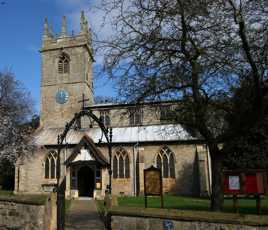 ClayworthSt PeterNewark Archdeaconry Bassetlaw and Bawtry Deanery Introduction
The village is called ‘Clavord’ in Domesday, but there is no mention of church.
The building is stone, some ashlar, and consists of a chancel, nave, aisles, south porch and embattled tower containing eight bells, the oldest of which are dated 1629, 1652 and 1722. The north aisle extends along the whole length of the nave and chancel; the south aisle is prolonged by St Nicholas’ Chapel (c1388).
The ground floor of the tower could be pre-Conquest or early Norman. Further up is a Norman window and the top is Perpendicular with eight pinnacles. The arcades of the two aisles are, according to Pevsner, very weird and not yet fully explained: the profile of the piers appears to have no connection with the profile of the arches.
There is a handsome oak screen between the nave and the chancel, and a heavy stone parclose screen between the south aisle and St Nicholas’ Chapel.
There is much stained glass, including several windows by C E Kempe, London.
There is a monument to Humphrey Fitzwilliam (1559), and a brass with a half-effigy of John Tonstall, rector 1630; also a fine monument to Francis Otter (1813) by Sir Richard Westmacott.
The outstanding feature of the church is the stunning murals in the chancel painted in 1904-5 by the Edinburgh artist Phoebe Anna Traquair. It is one of only two or three works by her in England.
Particular thanks to Dr Chris Brooke, Andy Nicholson and Nathan Ladd for
research on this entry
and to Geoff Buxton and Dr Chris Brooke for the photographs
|